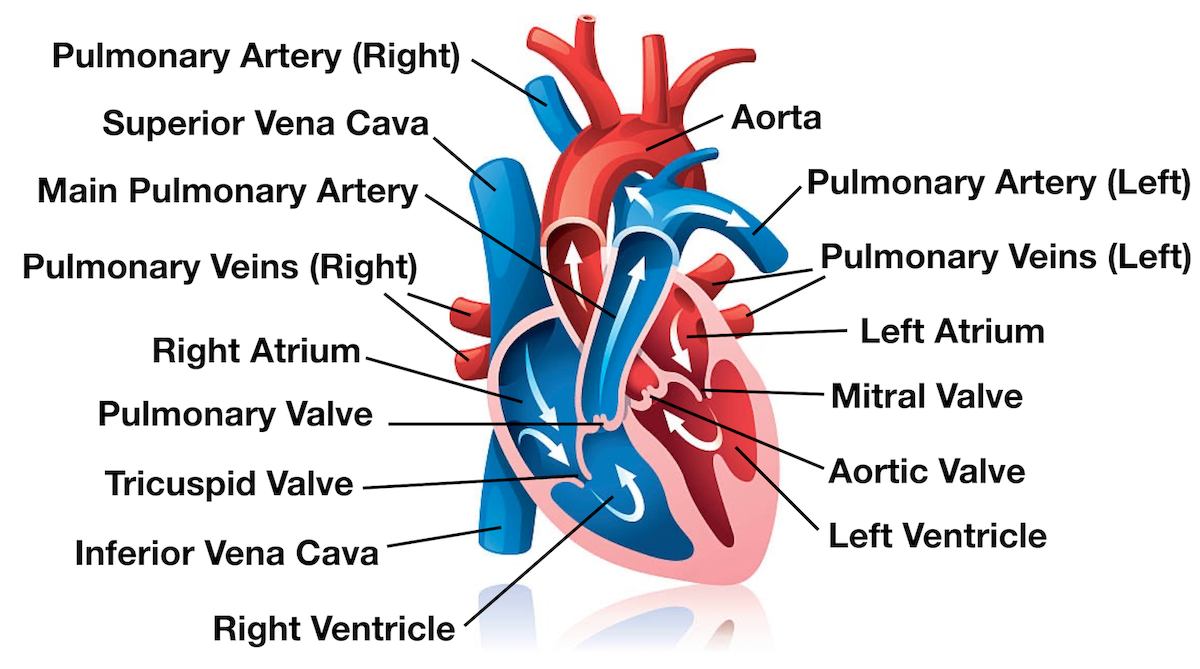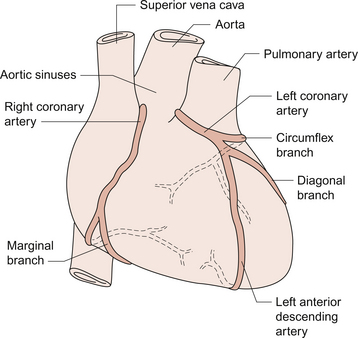Describe the blood supply to the heart. Coronary Arteries At the base of the aorta just after the aortic valves youve got two branches.

Blood Flow Through The Heart Step By Step Diagram
This amazing muscle produces electrical.

. LEFT CORONARY ARTERY RIGHT CORONARY ARTERY 6. Your blood carries the oxygen and nutrients that your organs need to work properly. Left Main Coronary Artery also called the left main trunk.
The heart is the four-chambered organ. They are named the left and right coronary arteries and arise from the left and right aortic sinuses within the aorta. What is the main arterial supply of the pericardium and where does it pass.
Pericardiacophrenic artery a branch of the internal thoracic artery which may accompany or parallel the phrenic nerve to the diaphragm. Anatomy of the arterial supply and venous drainage of the Heart The term coronary was first conceived to describe a crown-like arrangement of the arterial blood vessels supplying the heart muscle. 3 rows The blood supply to the heart arises from the left and right semilunar cusps of the aortic.
It is divided into two atria and two ventricles. Experts are tested by Chegg as specialists in their subject area. It is divided by a partition or septum into two halves.
ARTERIAL SUPPLY OF HEART The heart is supplied by TWO arteries Left coronary is larger in calibre and supplies more myocardium. Who are the experts. Supply of blood to the myocardium.
Like all other tissues in the body the heart muscle needs oxygen-rich blood to function and oxygen-depleted blood must be carried away. There are two main coronary arteries which branch to supply the entire heart. Also oxygen-depleted blood must be carried away.
In the most common distribution this comprises two major coronary. Also be sure to include where these blood vessels travel and what parts of the brain they supply. The superior vena cava comes from the upper part of the body including the brain and arms while the inferior vena cava comes from the abdominal area and legs.
From the left ventricle blood is pumped into the aorta so that it can be supplied to different organs. Valveless communications with the capillary beds of the myocardium and may carry blood from heart chambers to myocardium. This unidirectional flow of blood through the.
From the lungs blood goes to the left atrium through the pulmonary vein. Because of the watertight lining of the heart the endocardium and the thickness of the myocardium the heart cannot depend on the blood contained in its own chambers for oxygen and nourishment. Coronary arteries supply blood to the myocardium and other components of the heart.
If the heart is considered as an upside-down cone with the flat base placed at the level of the atrioventricular groove then the coronary arteries may be visualized as a ring at the base of the cone with branches which pass towards. The halves are in turn divided into four chambers. The heart is the organ that helps supply blood and oxygen to all parts of the body.
Inside the lungs carbon dioxide is removed from the blood and oxygen enters the blood. Arteries - they carry oxygen-rich blood from your heart to all parts of your body getting smaller as they get further away from the heart capillaries - they connect the smallest arteries to the smallest veins and help exchange water oxygen carbon dioxide and other nutrients and waste substances between the blood and the tissues around them. The term coronary was first conceived to describe a crown-like arrangement of the arterial blood vessels supplying the heart muscle.
Coronary arteries supply blood to the heart muscle. Right Coronary Artery It arises from the anterior aortic sinus of ascending aorta. Blood moves into the left ventricle.
Blood supply to the heart. The blood supply of the heart is also known as coronary circulation and the artery that supplies blood to the heart is known as the coronary artery. Blood enters the left atrium.
Two major coronary arteries branch off from the aorta near the point where the aorta and the left ventricle meet. Coronary arteries supply blood to the heart muscle. Two coronary arteries originate from the left side of the heart at the beginning root left ventricle.
Blood thats received from the lungs into the left side of the heart is pumped out of the aorta and the aorta has some branches which supply the heart. From the left atrium blood goes to the left ventricle. Blood is pumped into the aorta which carries oxygenated blood around the body.
Small branches dive into the heart muscle to bring it blood. The heart receives its own supply of blood from the coronary arteries. COURSE OF RIGHT CORONARY ARTERY 8.
Describe the blood supply to the brain begin your description from the left ventricle of the heart include the four blood vessels that supply blood to the brain as well as their branches terminal and non-terminal. Like all other tissues in the body the heart muscle needs oxygen-rich blood to function. We review their content and use your feedback to keep the quality high.
These arteries and their branches supply all parts of the heart muscle with blood. The aortic sinuses are small openings found within the aorta behind the left and right flaps of the aortic valve. Name the functional blood supply of the heart.
There are three aortic sinuses dilations in the wall of the aorta just superior to the aortic semilunar valve. It possesses a vascular system of its own called the coronary arterial system. BETWEEN PULMONARY TRUNK AND RT.
This system is a network of blood vessels such as arteries veins and capillaries that carries blood to and from all areas of your body. The coronary arteries wrap around the outside of the heart. What type of blood flows through the Superior.
The heart is situated within the chest cavity and surrounded by a fluid-filled sac called the pericardium. The vena cava is the largest vein in the body that delivers oxygen-poor or deoxygenated blood to the right atrium of the heart. Your heart is at the center of your circulatory system.


0 Comments